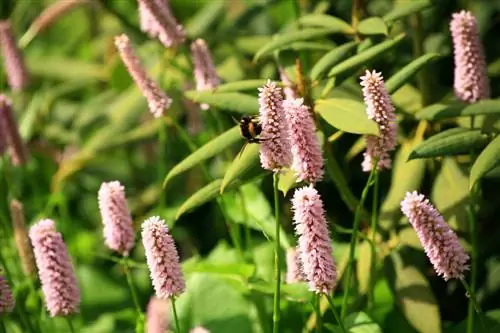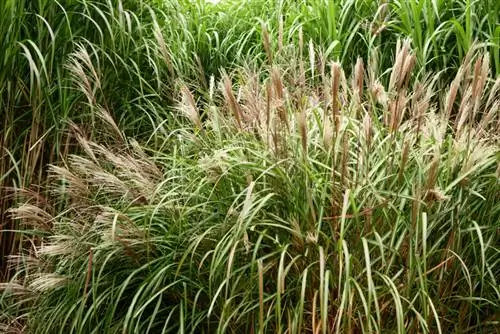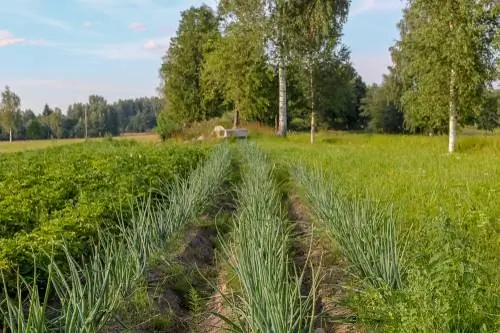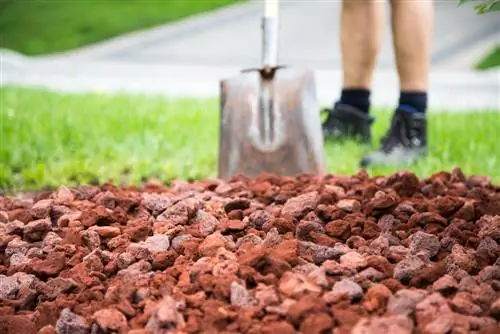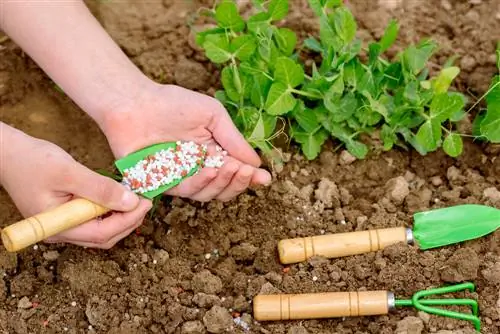- Author admin [email protected].
- Public 2023-12-25 17:45.
- Last modified 2025-01-23 11:22.
In the perennial bed, along trees or on the banks of the pond, knotweed decoratively rounds off the creative garden design. The perennial of the year 2012 impresses with its long flowering period, robust winter hardiness and frugal undemanding nature. Read here how easy planting and care are.
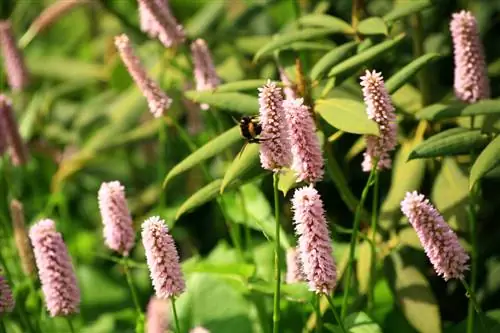
How do I care for knotweed in the garden?
Knotweed is a decorative perennial that is characterized by its long flowering period, robust winter hardiness and undemanding nature. When planting, it is important to have a root barrier, sufficient water supply, nutrient-rich soil and a sunny to semi-shady location. Care includes regular watering, pruning after flowering and winter protection measures.
Planting knotweed correctly
When planting, pay attention to the remarkable vigor that characterizes many knotweed species. So that the perennial does not set out on a conquest through the garden, mighty bush and candleweed or enormous climbing knotweed should be planted with a root barrier. For example, a large stone bucket (€64.00 on Amazon) or a bricklayer's tub without a bottom is suitable, as is the non-rotting geotextile specially developed for this purpose. Follow these steps:
- Put the root ball of the still potted young plant in water
- Dig a large planting pit and spread pottery shards or grit at the bottom as drainage
- Enrich the excavation with compost and horn shavings
- If necessary, install the root barrier that makes sense for large species
- Plant the potted knotweed up to the bottom pair of leaves and water
When blocking the roots, make sure that the knotweed has a sufficient substrate volume that is twice as large as the root ball. A mulch layer of leaves, grass clippings or bark mulch has a beneficial effect on growth.read more
Care tips
Planted in a sunny to partially shaded location in humus-rich, nutritious and freshly moist soil, a knotweed only requires the following care measures:
- Water regularly when the substrate surface has dried
- After flowering, cut back to the first pair of leaves
- In rough locations, provide a cover of leaves as winter protection
- Wrap the bucket with foil and place it on a wooden block
- If there is a clear frost, water on a mild day
If at all, knotweed receives starting fertilization in March/April. Pruning close to the ground should only be done in late winter so that the leaves provide additional protection for the root ball during the cold season.read more
Which location is suitable?
Knöterich feels best in a sunny to partially shaded location. The perennial is completely happy when the soil is nutrient-rich, humus-rich and fresh and moist. Mighty perennial lilacs, such as the St. John's Cloud, lose their stability in wind-exposed locations. The candlestick knotweed comes with maximum location tolerance and thrives in any location as long as it is not bothered by waterlogging.
The correct planting distance
The ideal planting distance depends on the species and variety chosen. Creeping snake knotweed thrives at a distance of 35 cm from its neighbor, while the popular candlestick knotweed should be planted at a distance of 90 to 100 cm. A majestic flower tower like the perennial lilac should not come closer than 150 to 200 cm to its plant neighbors.
What soil does the plant need?
The best knotweed species and varieties for private ornamental gardens largely agree on what the soil needs. They prefer to spread their roots in nutrient-rich, humus-rich and, above all, fresh, moist soil. Nevertheless, the genus has specialists for extreme situations, such as the water knotweed, which thrives wonderfully even in permanently wet soil on a pond bank.
What is the best time to plant?
For young plants in containers, planting time in the garden is from spring to autumn. A date between mid-May and mid-June or in early autumn to the end of September is beneficial for growth and vitality. During dry, hot summer days, planting is only successful if an adequate water supply is guaranteed.
When is flowering time?
The main flowering period of knotweed extends from June to September. When the spring weather is mild, the perennial lilac begins to bloom in mid-May, closely followed by the candleweed in June. If you don't get tired of their fragrant blossoms, you can also add the variegated leaf and knotweed, which bloom from September to October and end the garden year with furious autumn color.
Cut knotweed correctly
If the withered inflorescences take on an unsightly appearance, the scissors are used for the first time. After flowering, cut knotweed back to the top leaves on the stem. Leave the rest on the perennial until early spring as natural winter protection. Then use the pruning shears a second time to shorten the plants to just above the ground.read more
Watering knotweed
Knöterich depends on a generous water supply when it is dry. Even a rain shower sometimes doesn't penetrate through the dense flora of leaves and flowers. Therefore, check the substrate every 1-2 days and water when the surface has dried.
Fertilize knotweed properly
Knotweed has such powerful growth potential that no fertilizer is necessary in nutrient-rich soil. In poor locations and if there are symptoms of deficiency, apply a starter fertilizer in March/April. A portion of ripe compost with horn shavings is also an option, as is a small dose of complete fertilizer.
Wintering
The majority of knotweed plants are hardy. In rough locations and in planters, we still recommend the following protective measures for reasons of caution:
- Do not cut back knotweed completely before winter
- Heap the plant thickly with leaves and cover it with conifers
- Cover the pot with bubble wrap, place it on wood and cover the substrate with straw
A variety of popular knotweed species are sensitive to frost. Therefore, water the plant on mild winter days when there is no snow.
Propagate knotweed
Knotweed can be propagated effortlessly using cuttings. In early summer, select a half-woody, non-flowering shoot and cut off a 10-15 cm long piece below a leaf node. Defoliated except for the upper pair of leaves, plant two-thirds of the cutting in a lean substrate, such as potting soil or peat growing medium. This is how it continues:
- Put a perforated plastic bag over each pot
- Keep the substrate constantly moist in a partially shaded, warm location
- Air the cover daily to prevent mold
After 3-4 weeks, a knotweed cutting is sufficiently rooted to be planted in the bed or pot.read more
How do I transplant correctly?
Thanks to its natural vigor, knotweed usually tolerates a change of location without any damage. In early spring after pruning, cut off the root ball all around in the radius of the growth height. The subsequent digging can be associated with a high trimming effect due to the powerful root system. Do not leave any separated root pieces in the ground, as knotweed will sprout again in no time.
At the new location, the planting pit should be prepared and the excavation should be enriched with compost. Maintain the previous planting depth and water abundantly and regularly on the day of transplanting and afterwards.
Knotweed in a pot
In the pot, knotweed transforms the balcony into a blooming summer oasis. For vital growth and lush flowering, there are only a few aspects to be taken into account in care:
- Spread a drainage made of potsherds under the potting soil to protect against waterlogging
- Do not allow the substrate to dry out at any time
- Cut back in autumn to the first pair of leaves
- Cover the pot with foil in winter, place it on wood and cover the substrate with leaves
In spring, cut the overwintered knotweed back to the ground and repot the plant in fresh, nutrient-rich substrate. With this procedure, additional fertilizer is not necessary.
Is knotweed poisonous?
There is no question of knotweed being toxic. On the contrary, our ancestors already recognized its benefits as a medicinal and food plant. The tannins of the rootstock cure unpleasant diarrheal diseases, while the tender leaves and shoot tips make a delicious spring vegetable.read more
Which types of knotweed are suitable for the garden?
Growth-growing knotweed species, such as the creeping knotweed and the Japanese knotweed, brought the genus into disrepute as ruthless invaders. Today the tide has changed, as the disciplined growing and lushly flowering species have gained the attention of hobby gardeners. A selection of magnificent knotweeds for the garden at a glance:
- Candle knotweed: delicate flower candles over 40 cm long, heart-shaped foliage; sprawling growth up to 150 cm high
- Snail Knotweed: creeping species with compact growth and 20-30 cm high inflorescence; the ideal ground cover
- Colorful leaf knotweed: enchanting leaf decoration in autumn under white flower spikes for shady locations
- Bush knotweed: known as perennial lilac, thanks to its bushy habit up to 200 cm and lush flower bushes from May
The water knotweed is hard to beat when it comes to location tolerance. This species thrives both in water and on land and tolerates summer drought as well as waterlogging.read more
How do I keep creeping knotweed under control?
Thanks to its rapid growth rate, creeping knotweed with a climbing plant quickly covers meter-high facades and transforms fences into an impenetrable privacy screen. Since the plant does not stop growing on command once the desired size is reached, appropriate precautions in planting and care play an important role. Please note:
- Plant creeping knotweed with a stable root barrier
- Attach the climbing aid at least 10 cm away from the facade to avoid damage to the wall
- Maintain a distance of 150 cm from downpipes, lightning rods or gutters
Most importantly, keep the climbing plant under control with courageous pruning. Radically cut back a creeping knotweed in February or March. No fertilization is necessary in normal garden soil because the plant grows up to 30 cm per day even without additional nutrients.read more
Beautiful varieties
- St John's Cloud: majestic perennial lilac with white flower clouds and a growth height of up to 200 cm
- Superbum: extensive meadow knotweed for bank planting on the large pond with pink flowers from June to October
- Red Dragon: spectacular variegated knotweed with bright purple-red foliage and silvery V markings
- Taurus: lush blooming candlestick knotweed with rich red flowers and stable stability despite a height of 100 cm
- Darjeerling Red: enchanting snail knotweed for flat flower carpets throughout the summer

